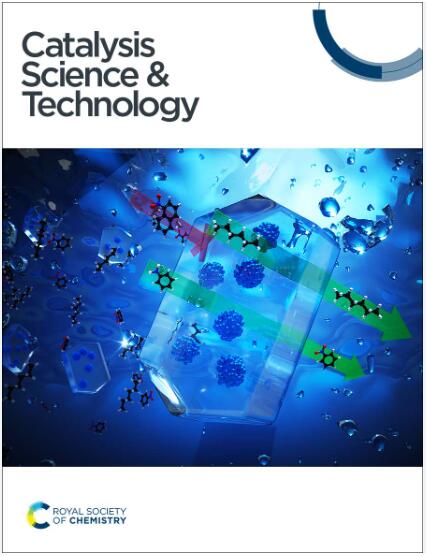Engineered In2O3 nanorods with abundant O vacancies significantly boost highly efficient photothermal CO2 hydrogenation into CO†
IF 4.4
3区 化学
Q2 CHEMISTRY, PHYSICAL
引用次数: 0
Abstract
Rising global demand for clean energy and carbon reduction challenges traditional CO2 conversion. Photothermal catalytic CO2 hydrogenation, powered by the combined force of light and heat, offers enhanced energy efficiency, lower reaction temperatures, and better product selectivity. Herein, a nanorod-shaped In2O3 catalyst rich in oxygen vacancies (Vos-In2O3) was synthesized. Compared to bulk In2O3, the rod-like structure effectively increases the catalyst's specific surface area, exposing more surface active sites. To facilitate reactant activation, oxygen defect engineering was implemented on the nanorod surface. The Vos-In2O3 exhibits a remarkable enhancement in the yield of photothermal CO2 catalytic reduction to CO, CH4, CH3OH, and CH3CH2OH at lower heating temperatures and atmospheric pressure. Notably, the CO production rate at an initial C/H ratio of 3 in the filling gas mixture was close to 421.90 μmol g−1 h−1, which was 24.3 and 30.9 times higher than that of In2O3 and bulk In2O3, respectively. The product selectivity of CO for Vos-In2O3 reached an outstanding 98.96%. Introducing O vacancies accelerates reaction kinetics and thermodynamics, and strongly promotes the efficient progress of the photothermal CO2 hydrogenation reaction.
具有丰富O空位的工程In2O3纳米棒显著提高了CO2光热氢化成CO†的效率
全球对清洁能源和碳减排的需求不断增长,对传统的二氧化碳转换提出了挑战。光热催化CO2加氢,由光和热的合力驱动,提供了更高的能源效率,更低的反应温度和更好的产物选择性。本文合成了一种富含氧空位的纳米棒状In2O3催化剂(Vos-In2O3)。与大块In2O3相比,棒状结构有效地增加了催化剂的比表面积,暴露出更多的表面活性位点。为了促进反应物的活化,在纳米棒表面进行了氧缺陷工程。在较低的加热温度和大气压下,Vos-In2O3光热CO2催化还原为CO、CH4、CH3OH和CH3CH2OH的产率显著提高。在初始C/H比为3时,CO的产率接近421.90 μmol g−1 H−1,分别是In2O3和本体In2O3的24.3倍和30.9倍。CO对Vos-In2O3的选择性达到了98.96%。O空位的引入加速了反应动力学和热力学,有力地促进了CO2光热加氢反应的高效进行。
本文章由计算机程序翻译,如有差异,请以英文原文为准。
求助全文
约1分钟内获得全文
求助全文
来源期刊

Catalysis Science & Technology
CHEMISTRY, PHYSICAL-
CiteScore
8.70
自引率
6.00%
发文量
587
审稿时长
1.5 months
期刊介绍:
A multidisciplinary journal focusing on cutting edge research across all fundamental science and technological aspects of catalysis.
Editor-in-chief: Bert Weckhuysen
Impact factor: 5.0
Time to first decision (peer reviewed only): 31 days
 求助内容:
求助内容: 应助结果提醒方式:
应助结果提醒方式:


